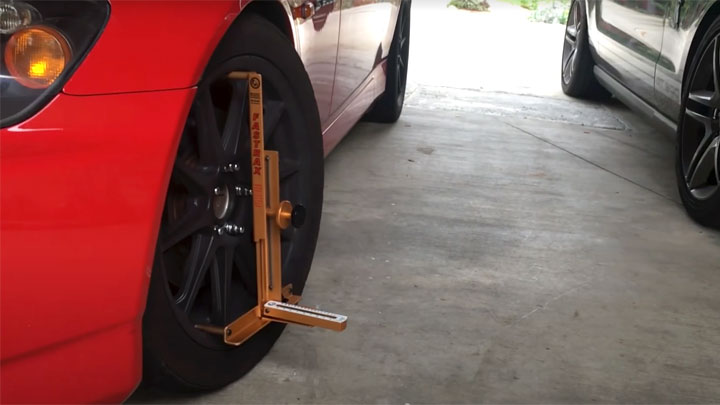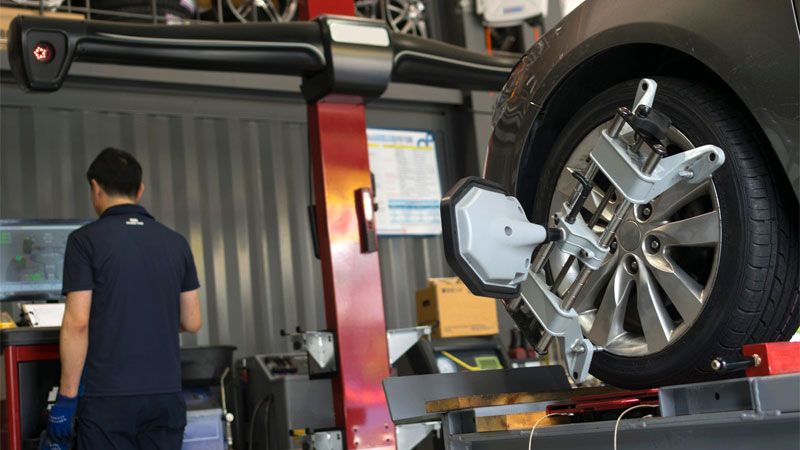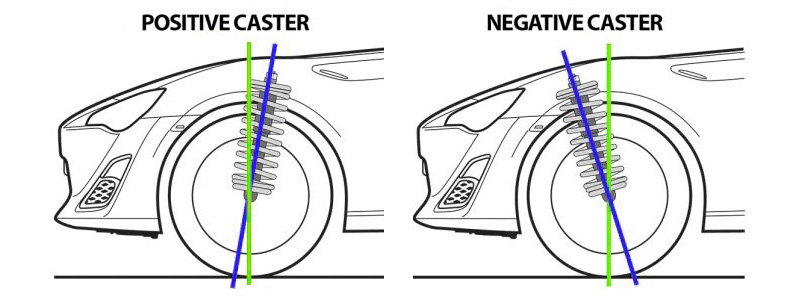It’s scary. A suspension word that could be pivotal to your car’s handling…or is it a natural remedy for constipation?
Although the latter would be a fun read, it’s more suspension-related and plays a great deal into your vehicle’s handling and driving characteristics.
Related – Average Cost of a Wheel Alignment
What is Caster?
Caster is the angle of the imaginary line that extends from your upper and lower steering pivot points. This angle is only viewed and accurate as you look directly at the side of the wheel of your vehicle. Your pivot points can also be referred to as “ball joints”.
Caster vs Camber
So, if caster is the angle of the imaginary line extending from your upper to lower ball joints, as viewed from the side—what on earth is camber? Contrary to what all the drift bois will be saying, camber is not the end-all-be-all modification to make your car into a super cool drift car. It’s important…but it’s not everything.
Camber is the angle of the imaginary line from the top of your wheel to the bottom. This is if you are looking directly at the tread of your tires, from the front of your car.
Positive camber means the top of your wheels are further to the outside of your vehicle than the bottom. You’ll notice this camber setting on more off-road-oriented vehicles like trophy trucks and rally cars. This is because you’ll have a better contact patch on your tires for more of the travel of your suspension than if you started with negative camber.
Negative camber is what you’ll see exaggerated in drift cars and slightly on race and street cars. This is when the tops of your wheels are angled further in toward the center of your car than the bottoms.
It gives your car a bit of the “stanced” or “squat” look, and also means you’ll have a better contact patch when you are at “full lock” when drifting. Negative camber also helps with turn-in when you’re on a track and can help your vehicle handle better.
See Also – Toe-In vs Toe-Out Effects on a Car
Do All Cars Have Caster?
Yep. All cars have upper and lower pivot points, however, not all cars have the ability to adjust your caster angle.
Most modern passenger cars have positive caster in the front to allow for better stability and steering ease. Generally, a car with positive caster would have been harder to turn if you didn’t have power steering available to you—I’m looking at you, old cars.
But now that pretty much all new cars have power steering, automakers have built cars with positive caster as there’s no steering downside.
Positive Caster Effects
If you have positive caster, you’ll have greater difficulty steering in non-power steering vehicles, but you’ll have better stability in general on the front of the car.
Furthermore, if you have positive caster, you’ll create what we call a “jacking” effect. This is when the front inside tire has less mass than the outside tire. This results in a better turn-in effect that can result in better cornering speed and, in effect, better lap times and time attack runs.
Negative Caster Effects
Ever notice how easy it is to turn a shopping trolley? Take a look at those wheels when you’re pushing it forward…that, my friend, is what we call negative caster. Its main benefit is the reduction in steering effort.
Steering Effort
So, in old cars that don’t have power steering, you may find yourself dialing in a bit of negative caster so it will be an easier car to live with in general. The same reason your grocery trolley is easy to turn and maneuver—negative camber.
While steering will be easier, if you have too much negative caster, you’ll find your steering to be extremely unpredictable and difficult to manage.
Stability
On the other hand, negative caster will make the vehicle harder to keep stable and will handle poorly in general. Furthermore, you’ll find that your negative caster becomes more extreme under heavy breaking, meaning the car will be harder to control under these kinds of forces.
TLDR: negative caster is only good if you want to steer easier in an older car, pretty much every other situation you are going to want positive caster.
How is Caster Adjusted?

Automakers of all sorts have equipped many road vehicles with caster adjustability. Some have fully adjustable upper and lower control arms where you can adjust caster by several degrees without even removing any bolts!
Other makes have cam bolts that allow for almost a degree of caster adjustment in either direction, but these bolts are tricky and prone to seizing… especially if you live in a salt-rich environment.
If your car or truck only has lower control arm adjustment, you’ll be able to adjust your caster angle by a few degrees by changing the lower control arm’s position. However, keep in mind that you’ll be adjusting the placement of your axle by quite a bit if you have a solid front axle. This could cause problems in the future.
In Motorsports
If you’re going to start drifting, going off-road, or doing any sort of racing, you may benefit from a proper front and rear suspension kit built for that sort of thing.
These kits allow all kinds of adjustments to your suspension, and they’re made to work together. This way you can experiment with caster, camber, toe, and other parameters as you figure out what works best for your style of driving.
See Also – Why Do Automakers Care So Much About Nürburgring?
Videogame Simulation
Another recommendation I have is to pick up a copy of Forza Motorsports, the racing simulator game. I’ve spent countless hours with this game trying to figure out how suspension geometry works and have found the descriptions next to each suspension parameter to be very informative.
Plus, you don’t need to get the car up on a lift every time you need to change your caster one degree negative or positive!
Getting Professionals Involved
While I don’t feel like you should need to get a mechanic for every little thing on your vehicle, if you ever feel like you’ve gone too far in one direction when adjusting your suspension geometry, you should take your car to an alignment shop.
They’ll know the terms you’re spittin in their direction and will be able to help you adjust your suspension to your specs.
Cheers,
Al
- The History of the Toyota MR2 in the US - May 11, 2023
- What Is Toe On a Car? (Toe-In vs Toe-Out Effects) - Aug 24, 2022
- What Is Caster On a Car? (Positive vs Negative Effects) - Aug 8, 2022


